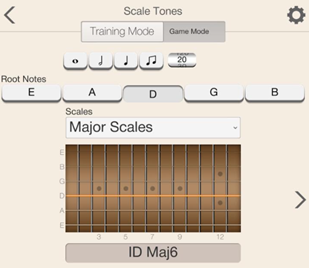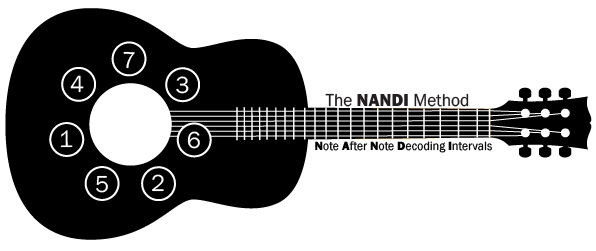The Major Scale
There are two main types of scales: major and minor. Let’s start with major, specifically C Major.
The C Major scale is generally thought of as the “default” major scale because it is the only major scale that is comprised completely of natural notes (no sharps or flats). If you play all the white keys on a piano starting from C you will hear a major scale. If we look at the below diagram, we will see a C major scale played on the B string.

We can see that the sequence of half and whole steps looks like this:
Whole, Whole, Half, Whole, Whole, Whole, Half
This directly corresponds to the scale degrees of the major scale:
1, 2, 3, 4, 5, 6, 7.
Of course, you won’t always be playing a C major scale, most of the time you probably will not. You’re much more likely to have to use the E major scale, but we have to figure out what notes are actually in the E major scale. To do that we start on E and follow the same sequence of half and whole steps.

Now we can see that the key of E major has four sharps: F#, G#, C#, D#.
If you follow this pattern for any note you start on, you will be able to play the major scale in every key and figure out what notes belong to each scale.
The Natural Minor Scale
Minor scales are the next most common scale after major, and are arguably more common in blues and rock music than major scales. Let’s start our understanding of minor scales with A natural minor.
1 2 ♭3 4 5 ♭6 ♭7 1
A B C D E F G A
We are using A minor because it is often thought of as the “default” minor scale because it is comprised entirely of natural notes (no sharps or flats). If you play the white keys on a piano starting from A you will hear a minor scale.
Unlike the major scale, which has scale degrees of 1, 2, 3, 4, 5, 6, 7, the minor scale looks like this:
1, 2,♭3, 4, 5,♭6, ♭7
Starting from the root, the sequence of whole steps and half-steps for a natural minor scale is as follows:
Whole, Half, Whole, Whole, Half, Whole, Whole
Below is an A natural minor scale (root on the open A string) with the whole-step half-step formula indicated in the illustration.

If you follow this same pattern for any given starting note, you will be playing in that note’s minor key.
If you wish to learn the notes in the major and natural minor scales with open string roots (E-A-D-G-B), our mobile app “Scale Tones” from the series “Guitar Intervals Unleashed” is available on Google Play & Appstore for only 99 cents!

